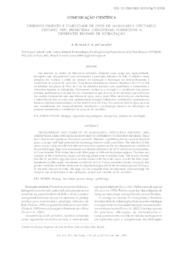Desenvolvimento e viabilidade de ovos de Mahanarva spectabilis (distant, 1909) (Hemiptera: cercopidae) submetidos a diferentes regimes de hidratação.
Desenvolvimento e viabilidade de ovos de Mahanarva spectabilis (distant, 1909) (Hemiptera: cercopidae) submetidos a diferentes regimes de hidratação.
Author(s): AUAD, A. M.; CARVALHO, C. A. de
Summary: RESUMO - São recentes os relatos de Mahanarva spectabilis (Distant) como praga em capim-elefante, forrageira com alto potencial para incrementar a produção intensiva de leite. O objetivo dessa pesquisa foi verificar o efeito do período de exposição à hidratação no desenvolvimento e viabilidade de ovos de M. spectabilis. Ovos foram mantidos em câmara climática a 28 ± 2o C e 12h de fotofase, em placas de Petri de 5 cm de diâmetro forradas com papel-filtro, e submetidos a diferentes regimes de hidratação. Diariamente avaliou-se a duração e a viabilidade dos quatro estádios embrionários e da fase de ovo. Constatou-se que os ovos de M. spectabilis que estiveram em contato diariamente com uma lâmina de água, com o papel-filtro umedecido ou umedecidos a intervalos de dois ou cinco dias, apresentaram durações inferiores e viabilidades superiores em todos os estádios embrionários e na fase total de ovo (20 dias). Na ausência total de água, os ovos não completaram seu desenvolvimento, denotando a participação decisiva da hidratação no período embrionário e viabilidade de ovos de M. spectabilis. ABSTRACT - There have been recent reports on Mahanarva spectabilis (Distant), a spittlebug that is a pest of elephant grass, a forage with high potential for increasing intensive milk production. The objective of this study was to verify the effect of different hydration regimes on the development and viability of M. spectabilis eggs. Eggs were maintained in a climatic chamber at 28 ± 2° C and 12-hour photophase, in 5-cm-diameter Petri dishes lined with filter paper at different hydration regimes. Duration and viability of the 4 embryonic stages and the egg phase were evaluated daily. The results showed that the M. spectabilis eggs that were in daily contact with the water layer, or with the filter paper moistened or filter paper moistened at intervals of 2 or 5 days presented shorter durations and greater viabilities in all the embryonic development stages and in the incubation period (20 days). In the total absence of water, the eggs did not complete their development, demonstrating the decisive role of hydration in the embryonic period and viability of M. spectabilis.
Publication year: 2009
Types of publication: Journal article
Unit: Embrapa Dairy Cattle
Keywords: Biologia, Cigarrinha-das-pastagens, Forrageiras, Período de incubação
Observation
Some of Embrapa's publications are published as ePub files. To read them, use or download one of the following free software options to your computer or mobile device. Android: Google Play Books; IOS: iBooks; Windows and Linux: Calibre.
Access other publications
Access the Agricultural Research Database (BDPA) to consult Embrapa's full library collection and records.
Visit Embrapa Bookstore to purchase books and other publications sold by Embrapa.

